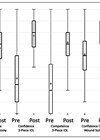Case Reports archive for 2023
Bosch-Boonstro-Schaaff optic atrophy syndrome (BBSOAS) NR2F1 mutation
An experienced ophthalmologist can make an anatomical diagnosis of childhood visual impairment based upon the surgical sieve, i.e., congenital and acquired. But an ophthalmologist cannot work in isolation to make an aetiological diagnosis – one would require the help of...
A case of retinal cavernous haemangioma – don’t let it slip through the grapevine
We present a case of a seven-year-old male who presented to the emergency eye referral clinic with red eye. He was diagnosed and treated for allergic conjunctivitis, however, on clinic review, wide field retinal imaging was performed (as has been...
Vitreous loss fire drills – ophthalmic simulation improves trainee surgical competence and confidence with posterior capsule rupture scenarios
Ophthalmic trainees have reported limited exposure and low confidence regarding the management of cataract complications such as posterior capsule rupture (PCR) / vitreous loss (VL). This report evaluates the impact of a simulation-based educational training event on these concerns. Introduction...
Unilateral central scotoma following dengue fever
Case report A 16-year-old Caucasian male was referred to the eye casualty at Nottingham University Hospitals NHS Trust by the infectious diseases unit in September 2013. He gave a history of photophobia, pain on eye movements and central blurred vision...
The madarosis mystery: unravelling the clues to a host of health issues
Eyelash madarosis is a medical condition characterised by the loss of eyelashes caused by the destruction of hair follicles. It can range from a few missing lashes to a complete absence of lashes on the eyelids. This condition can be...
Acute dacryoadenitis secondary to COVID-19
Acute dacryoadenitis is defined as the rapid onset of discomfort and swelling of the lacrimal gland, classically giving rise to an S-shaped ptosis [1]. Dacryoadenitis is the most common cause of a painful mass in the lacrimal gland in young...
Lessons from an unusual case of syphilis
The rise of syphilis transmission rates over the past two decades has been one of public health’s great puzzles. In the UK, the situation has reached epidemic levels, with a 126% increase between 2013 and 2018 [1]. We present a...
Retinal sequelae of high voltage electric current injury
Introduction High-voltage electrical currents may result in significant ocular complications, ranging from mild cataracts to vision-threatening retinal and optic nerve problems [1]. The severity of damage depends on various factors, including intensity and type of current, duration of exposure, entry...
Traumatic injuries from foam Nerf bullets
Background Three patients are presented in this case report: an adult and two children which were subjected to ocular injuries from Nerf gun bullets. Generally, Nerf guns are considered safer than airsoft guns. While there are many papers on airsoft...
A case of ‘60-day glaucoma’
Neovascular glaucoma (NVG) has been called ‘90-’ or ‘100-day glaucoma’ in the past due to its typical development three months after the onset of central retinal vein occlusion (CRVO). In reality, NVG can occur anywhere between two weeks and two...
Recurrent unilateral preseptal cellulitis secondary to herpes simplex virus infection
Introduction Periorbital (sometimes called preseptal cellulitis) is a common condition which on its own is not normally an ophthalmic or surgical emergency, however it has the potential to cause severe and serious morbidity in cases where the infection has crossed...
Periorbital and subconjunctival emphysema - a sign of orbital rim fracture
Background Orbital emphysema is a condition where air is present in orbit or periorbital tissues [1]. It is most commonly caused by trauma leading to orbit fracture, where air from paranasal sinuses is allowed to enter the orbit. The most...
















